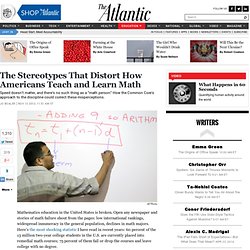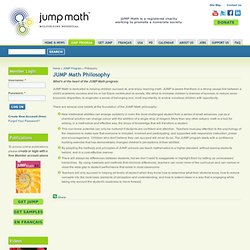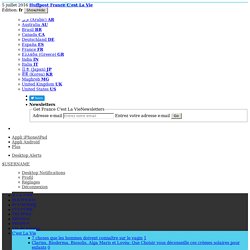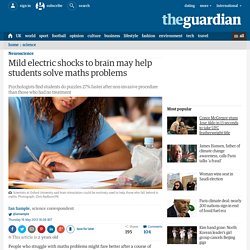

Banque de situations-problèmes mathématiques. The Stereotypes About Math That Hold Americans Back - Jo Boaler. Speed doesn't matter, and there's no such thing as a "math person.

" How the Common Core's approach to the discipline could correct these misperceptions. Mathematics education in the United States is broken. Open any newspaper and stories of math failure shout from the pages: low international rankings, widespread innumeracy in the general population, declines in math majors. Here’s the most shocking statistic I have read in recent years: 60 percent of the 13 million two-year college students in the U.S. are currently placed into remedial math courses; 75 percent of them fail or drop the courses and leave college with no degree.
We need to change the way we teach math in the U.S., and it is for this reason that I support the move to Common Core mathematics. I have spent years conducting research on students who study mathematics through different teaching approaches—in England and in the U.S. For example, consider the following two published test questions. 1. A both similar and congruent. JUMP Math Philosophy. What's at the heart of the JUMP Math program.

JUMP Math is dedicated to helping children succeed at, and enjoy, learning math. JUMP is aware that there is a strong causal link between a child's academic success and his or her future contribution to society. We strive to increase children’s chances of success, to reduce socio-economic disparities, to engender a sense of belonging and, most importantly, to endow voiceless children with opportunity. There are several core beliefs at the foundation of the JUMP Math philosophy: New intellectual abilities can emerge suddenly in even the most challenged student from a series of small advances, just as a chemical solution can change colour with the addition of a single drop of reagent. Is Algebra Necessary? My question extends beyond algebra and applies more broadly to the usual mathematics sequence, from geometry through calculus.
State regents and legislators — and much of the public — take it as self-evident that every young person should be made to master polynomial functions and parametric equations. There are many defenses of algebra and the virtue of learning it. Most of them sound reasonable on first hearing; many of them I once accepted. But the more I examine them, the clearer it seems that they are largely or wholly wrong — unsupported by research or evidence, or based on wishful logic.
(I’m not talking about quantitative skills, critical for informed citizenship and personal finance, but a very different ballgame.) This debate matters. The toll mathematics takes begins early. The Myth of 'I'm Bad at Math' - Miles Kimball & Noah Smith. “I’m just not a math person.”

We hear it all the time. And we’ve had enough. Because we believe that the idea of “math people” is the most self-destructive idea in America today. The truth is, you probably are a math person, and by thinking otherwise, you are possibly hamstringing your own career. Worse, you may be helping to perpetuate a pernicious myth that is harming underprivileged children—the myth of inborn genetic math ability. Is math ability genetic? How do we know this? Different kids with different levels of preparation come into a math class. Thus, people’s belief that math ability can’t change becomes a self-fulfilling prophecy.
The idea that math ability is mostly genetic is one dark facet of a larger fallacy that intelligence is mostly genetic. A body of research on conceptions of ability has shown two orientations toward ability. You have a certain amount of intelligence, and you really can’t do much to change it. The results? Mathe und Naturwissenschaften: Was Ost-Schulen so stark macht. Tiefgrün, also in der Landesfarbe, leuchtet das Bundesland Sachsen im Osten der Republik.

Die Deutschlandkarte illustriert die Unterschiede beim Ländervergleich 2012 in Mathematik und Naturwissenschaften. Eingefärbt sind die Länder nach der Leistungsstärke der Neuntklässler in Mathematik, Biologie, Chemie und Physik, und die Differenzen sind gravierend. Eine solche Karte sucht man in der Studie des Instituts zur Qualitätssicherung der Bildung (IQB) (hier als pdf) vergeblich. "Wie üblich ergeht der Appell von uns Wissenschaftlern an Sie, die einzelnen Rangplätze nicht überzubewerten", mahnte Institutsleiter Hans Anand-Pant, als er den Bericht vorstellte. Perspectives_maths_PISA_2012. Les Maths sur le bout des doigts. Myths_Flyer_final. Mathe-MOOC: Mathematisch denken! Kursbeschreibung Mathematik: das ist Freude am Denken!

Und mathematisch denken kann jeder! Wer an diesem Kurs teilnimmt, erhält seine regelmäßige Dosis an meditativen Denkaufgaben, spannenden Knobeleien und mathematischen Einsichten. In den Inhaltsgebieten Arithmetik und Geometrie werden mathematische Denk- und Arbeitsweisen vermittelt, beispielsweise Problemlösen, Begriffe definieren und Sätze finden und beweisen. Was lerne ich in diesem Kurs? Compétences et mathématiques. Synthese_etude_math2012. Global Education Digest. About EDUC115N. About This Course You can now register for the current offering of this course.

If you are interested in Jo Boaler's "How to Learn Math: For Students" course, the course is available here: How to Learn Math: For Students This course offers important new research ideas on learning, the brain, and math that can transform students’ experiences with math. Les formules mathémachistes. «Les filles, ça sait pas lire les cartes routières.

Alors, la géométrie dans l’espace…» Les clichés ont la vie dure et celui sur les femmes «pas faites pour les maths» continue de prospérer. Les filles osent toujours moins que les garçons les filières scientifiques. Des associations se battent pour surmonter ces préjugés et permettre aux filles de faire un choix plus libre. Mais cela ressemble à un puits sans fond. Les faits d’abord. On retrouve moins de 30% de filles dans les prépas scientifiques, réputées très concurrentielles, ce qui correspondrait davantage à un caractère viril… Elles ne sont guère que 27% dans les formations d’ingénieurs - ouvrant à des métiers de garçons, toujours dans l’imagerie populaire -, ou encore 28% en licence de maths.
Le 25 avril, Femmes et maths, avec l’association Animath, a organisé une journée «Filles et maths», la quatorzième depuis 2009. Apprendre et réussir en mathématiques ne dépend pas de l'intelligence mais du travail et de la discipline. EDUCATION - "Hugo est un crack aux échecs, pourtant son manque de confiance le met en échec en maths.

" Cette accroche publicitaire d'une entreprise de soutien scolaire très connue met le doigt là où ça fait mal. C'est pourtant un fait, il y a bien certains élèves pour lesquels progresser en maths relève de la gageure. Dans les salles de classe ou de retour à la maison, qui n'a jamais entendu un élève, un camarade, son fils ou sa fille dire que "les maths c'est trop dur, je ne suis pas intelligent pour réussir"? Maths education. People who struggle with maths problems might fare better after a course of gentle electric shocks to the brain, scientists have claimed.

Psychologists at Oxford University found that students scored higher on mental arithmetic tasks after a five-day course of brain stimulation. If future studies prove that it works – and is safe – the cheap and non-invasive procedure might be used routinely to boost the cognitive power of those who fall behind in maths, the scientists said. Researchers led by Roi Cohen Kadosh zapped students' brains with a technique called transcranial random noise stimulation (TRNS) while they performed simple calculations, or tried to remember mathematical facts by rote learning. In the study published in Current Biology, 25 students had electrical pulses fired across their brains, while 26 others had a sham treatment, in which they thought they had brain stimulation, but the equipment was turned off.